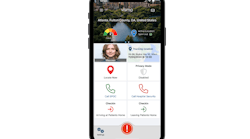Smartphone adoption among college students has risen to 89 percent (an increase of more than 61 percent in the past five years) and is expected to continue to expand in the coming years, according to a Ball State University study.
The increase of mobile phones on campus is correlated to the increase in calls to campus police from these devices versus landlines or blue light phones. Unfortunately, Wireless Enhanced 911 (E911) does not provide equivalent location accuracy to its landline-based E911 counterpart. Wireless E911 may take up to six minutes to report a caller’s latitude and longitude to authorities, according to Phase 2 of the US FCC requirement.
Blue light phones are commonly placed on university and college campuses and offer features such as two-way voice and being a visual representation of safety on campus; better models also offer strobe lights, sirens and streaming video. It is not uncommon for a fraction of these phones to be out of service on campus and require periodic maintenance and support. Certain universities have even made plans to remove these phones altogether in lieu of other communications alternatives.
With a growing need and desire to provide an enhanced set of information details about mobile callers including, location data, caller identification, along with other profile information such as a photo and known medical conditions for use by emergency dispatchers and responders at private and public institutions, colleges and universities have begun to explore new options.
Guardly Technology Solution Overview for OCAD University
As fresh approaches for campus communications evolve, it comes as no surprise that an innovative solution emerged at OCAD University, an art and design college in Toronto. In the fall of 2012, OCAD University began offering a free smartphone safety escort tool to its campus community, which allowed students, faculty and staff to communicate with campus security personnel in the event of an emergency or unsafe situation. The Guardly Safe Campus initiative was the result of a two-year joint project between the university and Guardly, a company that developed mobile safety apps, a cloud-hosted incident management system, and essentially emerged as a start up from OCAD U's Mobile Experience Innovation Centre incubator program. A six-month residency led to the development of the technology's core infrastructure and Guardly's first iPhone app.
Guardly designs and provides mobile safety solutions to help security teams better prepare for and respond to threats against people and key assets they protect. Guardly mobile safety apps, available on Android, iPhone, Windows Phone and BlackBerry, act as personal emergency phones that provide instant two-way communication with campus security/police and local 911 public safety answering points (PSAPs). Guardly's mobile safety applications, indoor positioning system and mobile mass notification technologies improve situational awareness by providing real-time indoor positioning / GPS data, caller identity and the nature of an incident — data otherwise not available to security operators.
Guardly Command is a web-based incident management system that helps security dispatch monitor, manage and respond to emergencies within their campus boundaries. These campus boundaries (or geo-fences) can be configured to work with multiple dispatch centers or persons assigned to safeguard different parts of a campus. The system provides real-time caller location, caller identification and profile information (including allergies, medical conditions, medications and other information). During an incident, dispatchers can speak with the caller by phone or engage in a conversation by secure chat.
Guardly mobile safety apps are provided to students, staff and faculty to transform their smartphones into virtual blue light emergency phones that can alert security dispatch from anywhere on campus as well as receive/reply to mobile mass notifications sent by campus security. The mobile application provides the ability to communicate with dispatch by phone and/or secure chat and track real-time location whilst ensuring privacy of students and staff in the process. The ability to share photos helps campus security better identify threatening individuals and make better response decisions.
Guardly mobile safety apps are free to download and are available on iOS (Apple), Android (Google), BlackBerry and Windows Phone 7/8 devices. Students and employees can register and download Guardly Safe Campus for free through the OCAD U website. Implementing Guardly in universities and colleges does not require any IT integration with campus law enforcement systems and can be done within hours. However Guardly does integrate with some other commercial systems out-of-the-box to make a unified system easier to setup for its customers.
The new service has positively impacted the accessibility of campus security to students and staff. “Guardly puts our services directly into students’ pockets, on a [mobile] platform they are especially comfortable with,” explained Louis Toromoreno, Assistant Director of Campus Security at OCAD University.
“OCAD U should be recognized as a leader and innovator in campus security. Louis and his team have provided Guardly with extremely valuable feedback that has gone on to help shape components of our solution,” adds Guardly Founder Josh Sookman.
Creating an integrated solution with OCAD U
Guardly’s technology is available in the cloud (hosted) and can be deployed with relative ease at any customer site or location. As such, Guardly Command (the security operator-facing incident management technology) was easily integrated into OCAD University’s existing command center, and is displayed at all times on one dedicated monitor. For the interface to function, it requires is an existing computer with a modern Internet browser and a functional Internet connection, and those resources were provided by OCAD University’s IT group.
Guardly’s technology is integrated with the geospatial jurisdictional environments that OCAD University Campus Security patrol and for which they will respond to inbound emergency alerts. This utilized the geo-fencing technology that enables the company to create geo-fences (virtual geographic boundaries) and allows the systems to selectively route incidents to the correct command center based on location.
Another component of the integration is Guardly Command hooking into OCAD University’s phone system to route inbound emergency calls. Those settings are stored within Guardly’s systems and did not require any changes at the customer site in order to function correctly. When a mobile emergency alert is triggered from within Guardly mobile apps, a call is automatically places to OCAD University’s dedicated emergency phone number.
Guardly’s Indoor Positioning System (IPS) integrates with OCAD University’s existing WiFi network to dynamically query network information, specifically access point BSSIDs and RSSIs, which Guardly IPS uses to determine indoor location positioning within buildings. No additional investments in network hardware infrastructure were required to provide this enhanced location service.
Although not leveraged yet by OCAD University, Guardly has an open and extensible API that can be leveraged to integrate with other incident management, mass notification or other third-party integrations to create a more integrated solution.
Innovation is the name of the game for this project
This is the first time that a cross-platform native mobile application has been integrated with an accurate indoor positioning system to provide inbound emergency alerting capabilities for students, staff and faculty at a university. In addition, this solution provides OCAD University with E911-like capabilities to locate smartphones accurate to the floor and room number within its buildings; this is a technological innovation that has not previously existed in the market and one that could become an industry standard over the next decade.
Until now, most enterprise customers or private organizations relied on inbound calls placed to designated phone numbers or the use of emergency duress phones while mobile and walking around their premises. Although emergency duress phones sometimes provide information around indoor location, they require the emergency caller to remain near the phone at all times, which can be limiting during an emergency. Guardly’s services allow inbound emergency callers to move about freely, and also provide personal details to campus police the moment that an emergency alert is sent from a smartphone.


